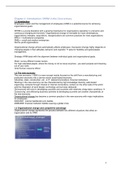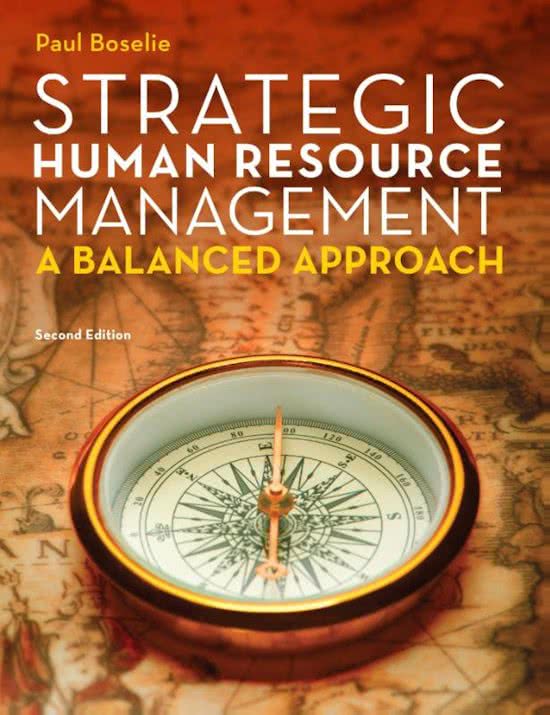Chapter 1: Introduction: SHRM in the 21st century
1.1 Introduction
Employees matter and the management of employees (HRM) is a potential source for achieving
organizational goals.
SHRM is a young discipline with a growing importance for organizations operating in a dynamic and
continuous changing environment. Organizational change is inevitable for most contemporary
organizations (mergers, acquisitions, reorganizations are common practices for most organizations.
MNCs = multinational companies
SMEs = small and medium enterprises
Not-for-profit organizations
Organizational change almost automatically affects employees. Successful change highly depends on
changing people in their attitudes, behavior and cognition → asks for flexibility and good people
management.
Strategic HRM deals with the alignment between individual goals and organizational goals.
Shein: survey different career ancers.
For high educated people, where the money is not an issue anymore, you want purpose and meaning
out of your work.
Chief human resource officer
1.2 The new economy
The new economy: (1990’s) a new concept mainly focused on the shift from a manufacturing and
production economy into a service sector asset-based economy.
Industries, steel, construction, etc. → IT, telecommunications, financial institutions.
Working in the new economy can be characterized by high knowledge intensity, web-based
organizing, contacts through intranet or internet connections, centers on the other side of the world
and the integration of work design, technology and services delivered.
Old economy still exist in developing countries and countries with relatively cheap labor conditions →
Outsourcing and offshoring business activities to developing countries are another characteristic of
the new economy.
Organizational change has become a common practice in the new economy with major implications
for employees.
2000/2001: internet bubble/dot-com bubble
2008/2009: financial institution bubble causing a global crisis
1.3 Organizational change and competitive advantage
Organizational change represents the process between two different situations that affect an
organization and its HRM.
1
,Competitive advantage: optimal coping with change. Competitive advantage is important for
organizational survival and is at least partly manageable by HRM.
Competitive advantage might be reflected in better financial performance and non-financial
performance (organization’s reputation in relation to the customers and potential employees).
‘An organization with competitive advantage is doing better than its competitors irrespective of the
actual firm performance (negative or positive). In the case of losses, the organization is still doing
better than its competitors. And in the case of profits, the organization makes more profits than the
others.’
1.4 The changing role of work in modern organizations
The rise of the new economy in the 1990’s created a shift from (traditional) production to services in
most Western societies. This shift has had a major impact on the nature of jobs in these societies
(computer more essential, different knowledge, technology created opportunities for alternative work
design f.e. work from home).
These new flexible work arrangements characterize modern organizations with benefits for both the
employer (e.g. improved personnel planning) and the employee (e.g. a better work-life balance).
The ageing population in many Western countries is also affecting work in modern organizations.
Baby-boomers are about to retire creating all kinds of employment issues: e.g. loss of valuable
knowledge, skills and abilities.
In some organizations the average employee age has gone up substantially causing personnel
planning issues in the future and the risk of ever-increasing labor costs related to older workers in
terms of higher salaries.
1.5 MHRM, IHRM and SHRM
SHRM can be a key to success in the process og organizational change; e.g. selecting top talent,
rewarding excellent performance, employee development and cultural management.
HRM = HRM involves management decisions related to policies and practices that together shape the
employment relationship and are aimed at achieving individual, organizational and society goals
(Boselie, 2002).
HRM = the management of work and people towards desired ends’ and they argue that this is a
fundamental activity in any organization with human beings as employees.
!Three mayor subfields in HRM:
MHRM (Micro HRM): Covers the sub-functions of human resource (HR) policy and practice,
including recruitment and selection, induction and socialization, and training and development.
MHRM is closely related to the studies in organizational behavior and occupational psychology
that focus on the impact of single HR practices on employee attitudes and behaviors.
Focused on the individual employee development
→ Inflow, throughflow and outflow (instroom, doorstroom en uitstroom)
Socialization, training and development, career development, more responsabilities,
outplacement, turnover, etc.
Each face requires different activities
IHRM (International HRM): Is concerned with HRM in MNCs and HRM across borders. It focuses
on issues such as the transferability of HR practices across business units in different countries,
the optimal management of expatriates and the impact of different institutional country contexts on
HRM.
Hofstede e.g.
SHRM (Strategic HRM): Focuses on issues of linking HRM to the business strategy, designing
high-performance work systems (HPWSs) and adding value through good people management in
an attempt to gain sustained competitive advantage. The concept of ‘fit’ plays a central role within
SHRM.
1.6 !Three perspectives (Multidimensional strategic HR model)
A multi-actor perspective:
Multiple stakeholders including employees, managers, HR professionals, work councils, trade
unions, top management, shareholders, financiers and government.
2
, A broad societal view:
Emphasis on different institutional contexts, e.g. on the level of branches of industry, regions
and countries.
A multi-level perspective:
Including the individual employee perspective and the strategic organizational perspective.
Team level HR research is very complicated you need advanced statistical techniques.
Nestedness of the data
The Multidimensional strategic HRM model is inspired by the European approach to HRM and
industrial relations. The model is reflected in Paauwe’s view on HRM, he argues that:
Human resources are something more than just ‘resources’
(people with feelings, emotions, interests and norms and values)
HRM is not concerned solely with financial performance
(behavior of people is not determined by economic rationality > sympathy towards others,
willingness to put extra effort into the job because professional norms, moral obligation,
personal norms and values for action, etc.)
HRM focuses on the exchange relationship between employee and organization
Legal elements (e.g. vacation days), economic aspects, psychologic contract (e.g. invest extra
time if they get promotion), social aspects (relations and networks; e.g. the bond with
colleagues).
Employment raltionship is focus of HRM characterized by following four contracts:
- Legal contract
- Economic or transactional contract
- Psychological contract (intangible)
- Sociological contract (intangible)
The shaping of the employment relationship takes place in an era of continuous tension between
the added value and moral values.
Psychological contract = exchange relationship
1.7 Tensions
HRM operates in an area of continuous tension between added valu and moral values.
Added value: economic side of organizing work and mainly represents the rome of HRM in creating
economic value and increasing financial performance of an organization.
Moral values: reflect the notion of employees as human beings with feelings, emotions, opinions,
norms and values.
Legge discusses the distinction between ‘hard’ HRM (resource management) and ‘soft’ HRM (human).
Rebalancing the approaches towards economic and moral aspects is one of the major challenges of
HRM.
The tension between financial and morality.
Boxall & Purcell comments on SHRM characteristics are also noteworthy, they argue that:
1. HRM covers all workforce groups, including core employees, peripheral employees and
contingent workers.
Core employees that’s where the focus is most of the time (e.g. teachers)
Peripheral employees they are neglected (e.g. cleaners)
2. HRM involves line and specialist managers, and is not solely aimed at employees
3. HRM is all about managing work and people, collectively and individually
4. HRM is embedded in industries and societies.
MD programs = management developments programs
Distinction between Anglo-Saxon models VS Rhineland models
- Anglo-Saxon or Anglo-American models: approaches in IR and HRM (e.g. in USA), mainly focus on
creating shareholder value in terms of profits and market value with little or no attention to other
stakeholders including trade unions and work councils.
- Rhineland models: Acknowledge multiple stakeholders and their interests explicity taking into
account employee interests in terms of well-being and societal interests. (Labelled ‘Rhine’ because of
the Rhine river in western Europe and the countries through which it flows).
3
, → Gospel and Pendleton argue that there are differences between Rhineland countries and therefore
we should be careful using this dichotomy.
1.8 The balanced approach
With globalization and increased competition there is a growing awareness that competitive advantage
depends on balancing market demands and institutional pressures.
In the strategic balance model, organizational success can only be achieved when financial
performance and societal performance of an organization are above average in the particular
population in which the organization is operating.
If one of them is high and the other one not (high financial outcomes but social issues or social
legitimacy without good performance on efficiency) a company is not going to survive in the long run.
The balanced approach in HRM:
- Goals of the individual employee
- Organizational goals
- Society goals
1.9 Framing HRM
Bolman and Deal present four different perspectives/frames for studying organizations:
1. Structural frame: seeks to gain an understanding of the various parts of an organization (rules,
roles, goals, policies, technology & environment)
2. HR frame focuses upon the employment relationship represents a specific way of looking at
organizations; mainly focused on concepts such as needs, skills and relationships of those
involved. Strong psychological background. (Family)
3. Political frame examines issues of power: power, conflict, competition and organizational
politics are the leading concepts in this perspective. (Jungle)
4. Symbolic frame builds on meaning and identity. The central concepts in this frame are
culture, meaning, metaphor, ritual, ceremony, stories and heroes (Hofstede)(Carnival, temple
and theatre).
→ SHRM is mostly studied from the structural frame making use of Mintzberg-like and Porter-like
structural approaches for defining HRM and studied from the HR frame blending organizational
behavior insights with organizational level HRM insights.
Stakeholders
Stakeholders are all relevant groups inside and outside an organization that affect strategic decision
making and strategic HRMN within an organization.
Stakeholder Illustrations of their interests Level
Shareholders High profits, growth and increased Strategic organization
market value
Employees Security, fun, meaningful work, Individual employee
development and challenges
Managers Productivity, quality, innovation and Team and departmental
status
Top management Reputation, shareholder value and Strategic organization
long-term success
Works councils Employment security and good Strategic organization and
working conditions individual employee level
Trade unions Employment, fairness and good Strategic organization and
working conditions individual employee level
Financiers ROI, financial health of organization Strategic organization
Local government Employment and environmental Strategic organization
pollution
National government Labour legislation and social legitimacy Strategic organization
Other interest groups Environmental pollution Strategic organization
Suppliers Reliability Strategic organization
Customers Costs, quality and innovation All levels
4






